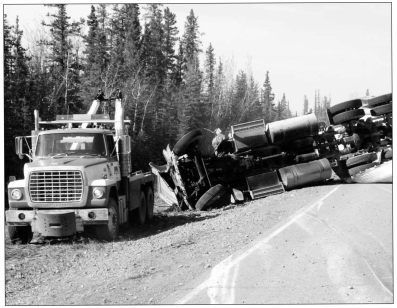C.
Tourism
Management:
Letter
Examples
PART
3
THIS
LETTER
IS
IN
SUPPORT
OF
A
LOWER
SPEED
LIMIT
THROUGH CHISTOCHINA, AK.

Wreck
at
mile
34
Tok
Cutoff
Hwy.
May
2002 |
THIS
LETTER
IS
IN
SUPPORT
OF
A
LOWER
SPEED
LIMIT
THROUGH CHISTOCHINA, AK.

Wreck
at
mile
31.5
Tok
Cutoff
Hwy.
May
2002 |
D.
Marketing
PART
3
THERE
ARE
SEVERAL
FACTORS
TO
CONSIDER
BEFORE
MARKETING
YOUR
BUSINESS
OR
COMMUNITY.
• WHAT
IS
SPECIAL
OR
UNIQUE
ABOUT
YOUR
SERVICE
OR ESTABLISHMENT?
There
are
a
growing
number
of
travelers
who
are
looking
for
an
authentic
community
and/or
cultural
experience.
They
don’t
want
to
stay
in
a
hotel
or
eat
at
a
food
chain.
Instead,
these
travelers
want
to
experience
real
people
and
the
community
they
live
in.
• ARE YOU AN ECOTOURISM BUSINESS?
DOES
YOUR
BUSINESS
INCLUDE
CULTURAL
TOURISM?
There
are
specific
marketing
venues
for
different
niches
in the tourism industry.
Advertising
as an ecotourism business
will generally attract a
specific type
of travelers.
• WHO
IS
YOUR
TARGET
AUDIENCE?
WHAT
DO
THEY
WANT?
Identifying
a
specific
type
of
traveler
will
help
you
develop
a marketing strategy that will appeal to their needs.
• HOW
CAN
YOU
ADVERTISE
IN
A
WAY
THAT
WILL
APPEAL
TO
THE
TARGET
AUDIENCE?
Put
yourself
in
the
travelers
shoes
when
developing
your
marketing
strategy!
Choose
pictures
and
printed
material
carefully
and
creatively.
• HOW
MUCH
MONEY
DO
YOU
HAVE
FOR
ADVERTISING?
Advertising
can
be
very
expensive.
Community
business
networking
can be particularly useful: Individual businesses can cut advertising costs
by
sharing
a
community advertising
space
such as a web site, a community business
brochure
or visitors
guide or a community display board. Another
way to circumvent the high
cost of advertising is to host
travel guidebook writers. A list of travel
guidebooks
is in
the resources section on page 48.
Something
to
consider...
Businesses that are owned and operated by people that are indigenous to the area
may benefit by advertising as a “Native owned” business. There are
travelers that want to support Native people and local businesses. If you advertise
as Native owned, be prepared to answer questions about your culture! |
The
four
most
common mediums for
small business
advertising
are:
1.
Printed
material
(travel guides, brochures, newspapers)
2.
Internet
(web
sites)
3.
Radio
4.
Word
of
mouth
and
roadside
signs |
 |

This
business
made
creative
use
of
their
mailbox
to
work
around
roadside
sign
laws.
The
Department
of
Transportation
mandates
roadside
sign
rules
for
the
State
of
Alaska. |
A
Visitors
Guide
is
an
effective
way
to
reach
tourists
and
let
them
know
the
community
guidelines.
It
is
also
a
great
marketing
tool.
The
Chistochina
Visitors
Guide
includes
general
information about
the
community
and
a
list
of
do's
and
don'ts.
The
inside
of
the
back
page
has
a
pocket
for
business
brochures
and
current
information. |
E.
Encouraging
Good Relations
Between Business
Owners
PART
3
GOOD
RELATIONS
BETWEEN
BUSINESS
OWNERS
ARE
EXTREMELY
IMPORTANT.
ANIMOSITY
BETWEEN
BUSINESSES
CAN
DAMAGE
THE
WHOLE
COMMUNITY
IN
TERMS
OF
TOURISM
OR
ECONOMIC
DEVELOPMENT.
Below
are
some strategies
for
encouraging
good
relations
between
business
owners.